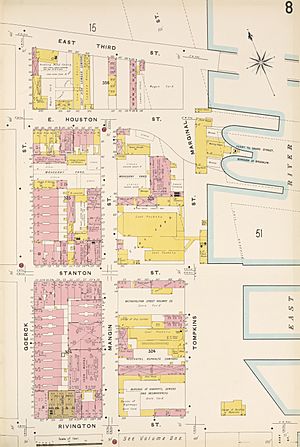Rivington Street municipal bath facts for kids
The Rivington Street municipal bath was a very important building in New York City. It was the first public bathhouse built with money from the city government. This bathhouse was located in the Lower East Side of Manhattan. This area was very crowded and many people lived there in 1900. The bathhouse cost $100,000 to build, which was a lot of money back then! It officially opened on March 23, 1901. Many people from different backgrounds used the bath, especially Jewish families from Hungary and Russia.
Contents
Why Public Baths Were Needed
In the early 1900s, many homes in New York City did not have their own bathrooms or showers. This meant people couldn't easily wash themselves at home. Public baths like the Rivington Street bath were built to help people stay clean and healthy. These baths were a big step forward for public health in the city.
How the Bathhouse Worked
The Rivington Street bathhouse was very modern for its time. It had 67 "spray baths," which are what we call showers today. These showers allowed many people to wash up quickly. The bathhouse could handle up to 3,000 baths every single day! Each person was allowed to use a shower for 20 minutes. This system made sure that everyone had a chance to get clean.
A Law for Public Baths
New York was the first state in the United States to make a law saying that cities must have public baths. This law was passed in 1895. It said that any city with more than 50,000 people had to build free public baths. Local health groups were in charge of keeping these baths clean and running. The law also said that the baths had to be open for 14 hours every day. Both hot and cold water had to be available for everyone.
Who Used the Bathhouse?
The Rivington Street bath was very popular. In just the first five months of 1902, over 224,000 people used the bathhouse! This included more than 66,000 women and girls. It shows how much people needed and used these public facilities to keep clean.
The Bathhouse Closes
Over time, more and more homes started to get their own showers and bathrooms. Because of this, fewer people needed to use the public bathhouses. Many of these city-run bathhouses were eventually turned into public swimming pools. The Rivington Street bathhouse stopped being used in 1975. The city sealed up the building, and it has not been used since then.


